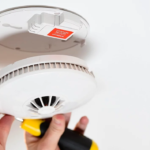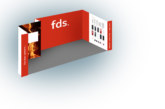As housing associations and social housing providers across the UK look to maximise asset protection whilst simultaneously providing the highest standard of safety for tenants, connective technologies are presenting a new proactive approach that offers unlimited opportunities for data access across multiple property portfolios. Nick Rutter, Chief Product Officer at FireAngel, explores the latest innovations available to social housing providers to not only help achieve full compliance while minimising running costs, but provide intelligent connected solutions that can be adapted for the future.
From struggling to gain access to properties, to overcoming issues regarding the adequate measurement and management of property risk, social housing providers across the UK are facing increasing pressures, specifically with regard to fire safety.
There are a number of complications associated with missed tenant appointments and the difficulty engineers experience when trying to gain access to properties to conduct necessary maintenance and repairs. This is resulting in not only a reduction of the level of protection potentially provided, but ultimately costly consequences, particularly with regard to the expensive cost of repair following a fire.
However, taking a proactive approach to implementing preventative fire safety measures and utilising connected technologies removes the physical barriers many providers traditionally face. Instead housing providers can ensure full compliance across their entire housing stock, whilst understanding and meeting fire safety requirements of the future.
Following the Hackitt Review, the social housing sector is looking to adopt its principles to ensure the long-term efficiency of their properties with regard to fire safety. While specifying smoke and heat alarms that quickly and effectively respond to all types of fires is essential, providers can go above and beyond legal requirements by choosing advanced solutions that react in real time to potential or actual fire events.
While ionisation sensing technology was traditionally a popular choice due to its low price point and outstanding ability to detect fast-flaming fires, the concerns regarding its potential radioactivity and sensitivity quickly began to outweigh its benefits.
To ensure the quickest response times are ensured for all types of fires and maintain compliance with current standards and regulations, including the 2019 revisions to the British Standard 5839-6, multi-sensing or optical alarms should be specified throughout circulation areas, including landings and hallways. This provides a basis for ensuring all minimum requirements with regard to fire safety are met, whilst also following the guidance of the UK Fire and Rescue Services.
However, there are a wide range of connected technologies currently available to aid professionals in taking this compliance one step further, supporting them in adopting a proactive approach that ensures the long term safety and suitability of their properties, whilst complying to an LD1 Specification.
While Scotland takes significant strides in improving the energy efficiency of its social housing stock through EESSH2, providers across other areas of the UK are also looking to supply solutions that not only offer the highest levels of protection, but actively improve the long-term sustainability of their operations.
Typically, a smoke alarm spends 99.9% of its time in standby, dissipating the unused energy through heat, which is extremely inefficient. Once the alarm is activated, a significant increase in power is utilised, which is commonly provided by ‘dropping’ the voltage from the mains power supply.
However, latest developments have led to the creation of mains-powered, low carbon footprint ranges that are Smart RF compatible and feature an intelligent ‘step down’ circuit that monitors the active state of the alarm to adequately manage the power available. This ensures the alarm uses just 10% of the energy when compared to the average AC alarm, significantly improving the long-term efficiency of the alarm throughout its 10-year lifespan.
For social housing providers with all sizes of housing stock, the potential to have a running cost as little as 60p per alarm over 10 years can lead to significant reductions in energy output and subsequent savings with regard to operating costs.
As the range is Smart RF compatible, it also provides professionals with the adaptability to futureproof their properties to meet the specific needs of future residents and comply with future legislations. Offering the benefits of both Thermoptek and Thermistek sensing technology to adequately respond to all fire types, it supports the adoption of a mixed system that interlinks hardwired and wireless mains and battery powered alarms.
A mixed system (also known as a hybrid system) not only provides the opportunity to adopt both 230V mains AC 50Hz and DC battery alarms, but also offers the ability to include Smart RF ready alarms. This provides enhanced flexibility as additional smoke, heat, CO and specialised assisted living products (such as a wireless alarm control unit and strobe and pad), can be wirelessly added or removed to a network, dependent on the specific needs of a tenant and their level of risk.
This enables providers to achieve a higher standard of fire protection throughout an entire property, where previously a hardwire interlink may not have been possible. Smoke, heat and CO alarms can be wirelessly meshed together on a private network, so when once alarm sounds, they all sound to immediately notify individuals of a potential fire or CO event, aiding a safer and quicker exit. A faster response can also minimise the potential fire damage to the property.
As the alarms are Smart RF compatible, professionals have the flexibility to upgrade the system by fitting a Smart RF radio module into the alarm. This allows wireless interlinking of up to 50 alarms within one network, enabling the opportunity to also access vital information including current status, alarm history, replacement dates and network health through the activation of a cloud-based connect gateway.
By utilising a connect gateway, which uses a unique algorithm and features patented Predict technology to identify and highlight high-risk patterns of behaviour with regard to fire safety, it bridges the gap in communication by instantly notifying necessary individuals in the event of an alarm activation. For example, high risk or vulnerable individuals, such as those living alone, anyone hard of hearing or living with dementia, who may leave the hob on after cooking a meal, can be remotely overseen in real time as the connect gateway sends live updates to designated individuals regarding the status of the smoke, heat and CO alarms installed throughout the property.
By adopting a proactive and connected approach to the fire and CO protection systems installed throughout their portfolio, social housing providers can not only ensure compliance with all current legislations, but sufficiently safeguard their tenants and properties, and future proof against any upcoming changes to relevant building regulations.
The adaptable technology also offers the opportunity for social housing providers to easily upgrade the fire protection systems installed throughout their entire housing stock at a later date, subsequently reducing the potential asset management challenges and associated costs they may have previously experienced. The remote monitoring capability that connected technologies offer also provide a revolutionary approach to preventative fire safety that delivers the highest standards of protection in the most cost-effective way.
For more information on FireAngel and its range of interlinked smoke, heat and carbon monoxide alarms, visit www.fireangel.co.uk/connect or contact your local specification manager,









